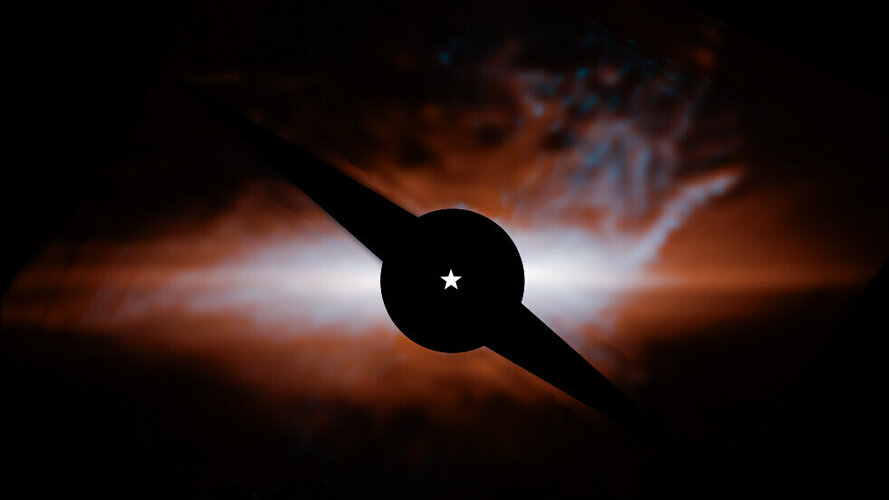You think you know someone, then you see them in a slightly different way and BAM, they surprise you. I’m not talking about other people of course, I’m talking about a fabulous star that has been studied and imaged a gazillion times. Beta Pictoris has been revealed by many telescopes, even Hubble to be home to the most amazing disk. Enter James Webb Space Telescopd and WALLOP, with its increased sensitivty and instrumentation a new, exciting feature emerges.
Beta Pictoris is the second brightest star in the southern constellation Pictor. It is a very young star, thought to be about 20 million years old and at a distance of just 63 light years, is in our cosmic backyard. Observations in 1984 revealed that Beta Pictoris had the most amazing dust disk out of which planets are forming. The European Southern Observatory has since confimred there are at least two planets (imaginitively called Beta Pictoris b and Beta Pictoris c) orbiting within the dust disk.
Over the years, Beta Pictoris has been the target for many observations including those from the Hubble Space Telescope that revealed a second, previously unseen disk. The second disk is slightly inclined to the first but further observations from the James Webb Space Telescope (JWST) have revealed a new structure in this second disk.
The team, led by Isabel Rebollido from the Astrobiology Center in Spain used the Near-Infrared Camera (NIRI) and the Mid-Infrared Instrument (MIRI) of the JWST to explore the disks of Beta Pictoris in more detail. They were surprised to find a new structure at an angle to the secondary disk that was shaped like a cats tail. Despite the plethora of previous observations including those from the space busting HST, the instruments on JWST are more sensitive and have greater resolution.

The “Cat’s Tail” was not the only surprise. When the MIRI data was studied, it revealed that the two disks were different temperatures revealing they were composed of different material. The secondary disk and Cat’s Tail were shown to be a higher temperature than the main disk. It’s also easy to deduce they are both made of dark material since they have not been previously observed in visible or near infra-red light but are bright under mid infra-red wavelengths.
One of the theories to explain the higher temperature is that the material is highly porous, similar perhaps to the material found on comets and asteroids. The nature of the dust is one question that is perhaps easily addressed, something a little more challenging to answer is the nature and origin of the Cat’s Tail.
The team explored a number of possible hypotheses that could explain the tail’s shape but failed to settle on a satisfactory model. One of their favoured theories is that the tail is the result of an event that occured within the disk around a hundred years ago! The event may have been a collision sending the dust into a trajectory that mirrors that of the impactor but then it starts to spread out to produce a curve. A contributory factor may simply be the angle of the tail from our vantage point causing the angle of the tail to seem steeper than it actualy is.
One thing is for certain, the recent observations of Beta Pictoris have revealed some surprises of a very well loved and observed object. Further research will help us to gain a more fuller understanding of these new features but it leaves me wondering what other objects that we are familiar with still hold some surprises.
Source : Webb discovers dusty cat’s tail in Beta Pictoris system


I reject the whole idea of multiverses as it, in my view, contradicts thermal dynamics completely. Thermal dynamics states that energi can not be created, only converted. Multiverse theory says that an infinity of entire universes of energy is created out of nothing every second.